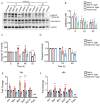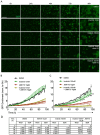An Optimized Peptide Antagonist of CXCR4 Limits Survival of BCR-ABL1-Transformed Cells in Philadelphia-Chromosome-Positive B-Cell Acute Lymphoblastic Leukemia
- PMID: 39125877
- PMCID: PMC11312813
- DOI: 10.3390/ijms25158306
An Optimized Peptide Antagonist of CXCR4 Limits Survival of BCR-ABL1-Transformed Cells in Philadelphia-Chromosome-Positive B-Cell Acute Lymphoblastic Leukemia
Abstract
Philadelphia-chromosome-positive acute lymphoblastic leukemia (Ph+ ALL) is characterized by reciprocal chromosomal translocation between chromosome 9 and 22, leading to the expression of constitutively active oncogenic BCR-ABL1 fusion protein. CXC chemokine receptor 4 (CXCR4) is essential for the survival of BCR-ABL1-transformed mouse pre-B cells, as the deletion of CXCR4 induces death in these cells. To investigate whether CXCR4 inhibition also effectively blocks BCR-ABL1-transformed cell growth in vitro, in this study, we explored an array of peptide-based inhibitors of CXCR4. The inhibitors were optimized derivatives of EPI-X4, an endogenous peptide antagonist of CXCR4. We observed that among all the candidates, EPI-X4 JM#170 (referred to as JM#170) effectively induced cell death in BCR-ABL1-transformed mouse B cells but had little effect on untransformed wild-type B cells. Importantly, AMD3100, a small molecule inhibitor of CXCR4, did not show this effect. Treatment with JM#170 induced transient JNK phosphorylation in BCR-ABL1-transformed cells, which in turn activated the intrinsic apoptotic pathway by inducing cJun, Bim, and Bax gene expressions. Combinatorial treatment of JM#170 with ABL1 kinase inhibitor Imatinib exerted a stronger killing effect on BCR-ABL1-transformed cells even at a lower dose of Imatinib. Surprisingly, JM#170 actively killed Sup-B15 cells, a BCR-ABL1+ human ALL cell line, but had no effect on the BCR-ABL1- 697 cell line. This suggests that the inhibitory effect of JM#170 is specific for BCR-ABL1+ ALL. Taken together, JM#170 emerges as a potent novel drug against Ph+ ALL.
Keywords: AMD3100; BCR–ABL1; CXCR4; EPI-X4 derivatives; Imatinib; cell survival.
Conflict of interest statement
M.H. and J.M. are co-inventors of pending and issued patents that claim to use EPI-X4 (ALB408-423) and its derivatives for the therapy of CXCR4-associated diseases.
Figures






Similar articles
-
Synergism between IL7R and CXCR4 drives BCR-ABL induced transformation in Philadelphia chromosome-positive acute lymphoblastic leukemia.Nat Commun. 2020 Jun 24;11(1):3194. doi: 10.1038/s41467-020-16927-w. Nat Commun. 2020. PMID: 32581241 Free PMC article.
-
HDAC1,2 inhibition and doxorubicin impair Mre11-dependent DNA repair and DISC to override BCR-ABL1-driven DSB repair in Philadelphia chromosome-positive B-cell precursor acute lymphoblastic leukemia.Leukemia. 2018 Jan;32(1):49-60. doi: 10.1038/leu.2017.174. Epub 2017 Jun 5. Leukemia. 2018. PMID: 28579617 Free PMC article.
-
RUNX1 transactivates BCR-ABL1 expression in Philadelphia chromosome positive acute lymphoblastic leukemia.Cancer Sci. 2022 Feb;113(2):529-539. doi: 10.1111/cas.15239. Epub 2021 Dec 28. Cancer Sci. 2022. PMID: 34902205 Free PMC article.
-
Next-generation sequencing for BCR-ABL1 kinase domain mutations in adult patients with Philadelphia chromosome-positive acute lymphoblastic leukemia: A position paper.Cancer Med. 2020 May;9(9):2960-2970. doi: 10.1002/cam4.2946. Epub 2020 Mar 10. Cancer Med. 2020. PMID: 32154668 Free PMC article. Review.
-
Tyrosine kinase inhibitors for the treatment of Philadelphia chromosome-positive adult acute lymphoblastic leukemia.Cancer. 2007 Sep 15;110(6):1178-86. doi: 10.1002/cncr.22881. Cancer. 2007. PMID: 17701954 Review.
Cited by
-
CXCR Family and Hematologic Malignancies in the Bone Marrow Microenvironment.Biomolecules. 2025 May 13;15(5):716. doi: 10.3390/biom15050716. Biomolecules. 2025. PMID: 40427609 Free PMC article. Review.
-
GPR15LG binds CXCR4 and synergistically modulates CXCL12-induced cell signaling and migration.Cell Commun Signal. 2025 May 20;23(1):234. doi: 10.1186/s12964-025-02231-x. Cell Commun Signal. 2025. PMID: 40394646 Free PMC article.
-
CXCR4 Inhibition Enhances the Efficacy of CD19 Monoclonal Antibody-Mediated Extermination of B-Cell Lymphoma.Int J Mol Sci. 2025 Feb 26;26(5):2024. doi: 10.3390/ijms26052024. Int J Mol Sci. 2025. PMID: 40076664 Free PMC article.
References
MeSH terms
Substances
Grants and funding
LinkOut - more resources
Full Text Sources
Research Materials
Miscellaneous

